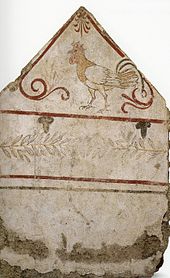Tomb of the White Rooster
The grave of the white rooster , also known as the white grave , is a women's grave from around 340 BC. BC, which was found in the Andriuolo necropolis near Paestum and was given the number 53 there. His remains are in the National Archaeological Museum in Paestum ; the eponymous plate bears the inventory number 21554.
description
Framed by red lines that end in a double volute at the bottom , the eponymous painting is located in the gable of the plate, which once formed the narrow western side of the tomb. It is 147 cm high and 98 cm wide. The rooster is different from its conspecific from the grave of the colorful rooster, drawn with a dark outline. The head, neck, parts of the legs and the straight tail feathers are brownish, in the crest there are four red rays, the curved tail feathers are almost black. The animal can be seen in profile to the left and stands above a red crossbar that separates the gable from the rectangular part of the plate. Two dark grapes hang down from this bar, which, like the rooster, are a symbol of fertility. Below there is a leaf tendril over two further horizontal bars. In contrast to many other Lukan graves from the Paestum area, the base zone is not painted in red.
The other slabs of the burial chamber are very fragile. On the other narrow side of the grave there was once a plate with a singing gnome next to a flute player in the gable , apparently a scene from an atellane . The side panels show scenes from the funeral games - a lance-piercing fight and a chariot race - and the laying out of the dead.
literature
- Bernard Andreae et al. a .: painting for eternity. The tombs of Paestum. Exhibition at Bucerius Kunst Forum Hamburg, October 13, 2007 to January 20, 2008. Hirmer, Munich 2007, ISBN 978-3-7774-3745-3 , pp. 132-133.
